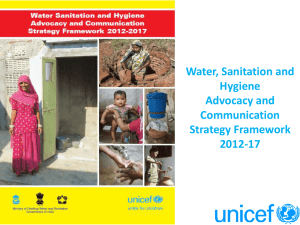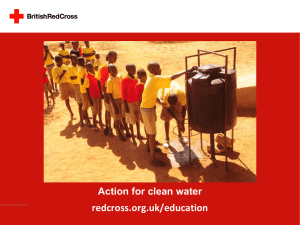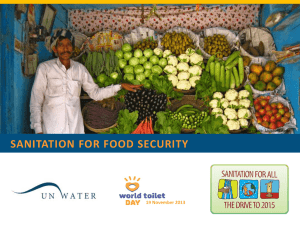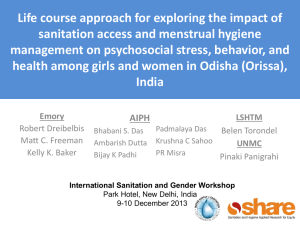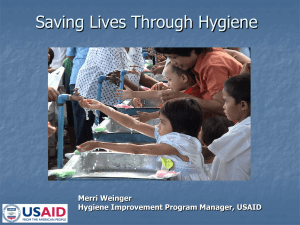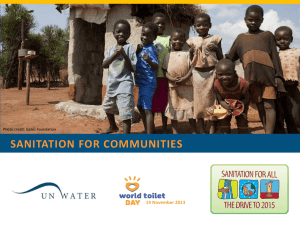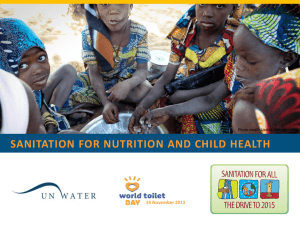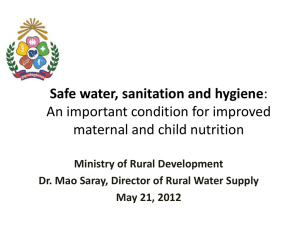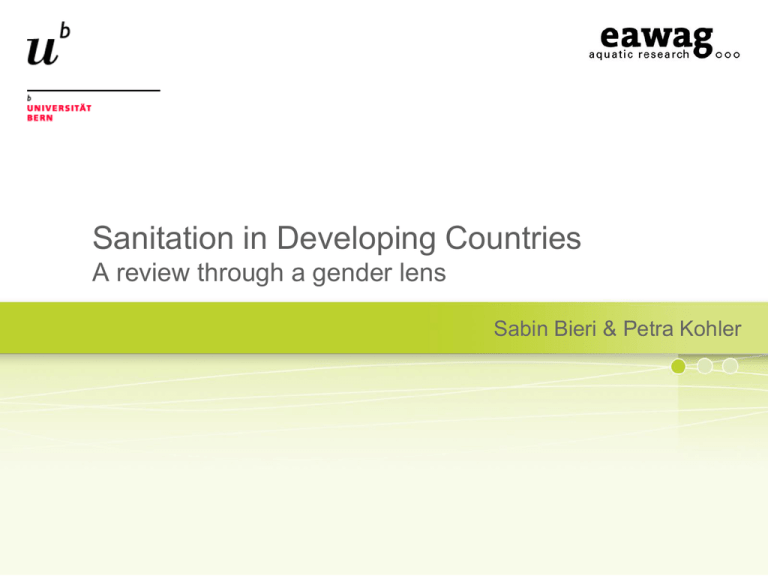
Sanitation in Developing Countries
A review through a gender lens
Sabin Bieri & Petra Kohler
Content
• Introduction, background NCCR, RP09
• Introduction to the article
• Background; Entry points for a gender analysis
• Overview of the article:
Policy and programming
Technology
Methods
Conclusions + recommendations
• Outlook
• Discussion with the group
Introduction
UNICEF
The Millennium Development Goals (MDGs) on water and
sanitation
‘‘…cannot be met without the full participation of women – as
care-givers, workers, beneficiaries of services and decisionmakers in homes, communities and at national levels – and
without addressing the inequities suffered by girls.”
(www.unicef.org/wes/index_womenandgirls.html, 2008)
Introduction
Fields of interest/lack of data
1. Gender and water/sanitation
2. Time use
3. Decision making and policy
4. Costs and benefits
Introduction
Structure of the article
1. Introduction
2. Conceptual thoughts on Gender & Sanitation
3. Policy and programming
4. Technology
5. Adequate methods for investigating delicate subjects
6. Conclusions and recommendations
Background: Entry points for a gender analysis
The primary concern is to theorise a social identity not
predetermined by ‘sex’ and free from arbitrary
naturalisations of a given gender order.
(adapted from: Jackson & Pearson, 1998)
Background: Entry points for a gender analysis
sex:
gender:
biological category
social and cultural implications of what it
means to be a man or a woman
Background: Entry points for a gender analysis
Gender is something that we do.
Gender is something that is done to us.
Background: Entry points for a gender analysis
What is at stake is the question of what the categories
‘man’ or ‘woman’ signify and which social realities and
cultural norms are described and contained therein.
Background: Entry points for a gender analysis
“… gender becomes a powerful sealant for multiple
dimensions of social inequality.“
(Chari, 2004)
Background: Entry points for a gender analysis
…to genderize sanitation for our purpose here means to
conceive the gendered sanitation experience as much as
a social product as it is a material reality.
Background: Entry points for a gender analysis
The goal should be for women and men to feel as
comfortable as possible when they practice their daily
hygiene.
Policy and Programming
Paradigm shift from technology- and supply-oriented
towards demand-oriented and user-centred approaches
•
User-driven approaches offer entry points for a genderconsiderate analysis and for corresponding technologies
to address specific sanitation requirements of women and
girls
Questions to check up on reality:
?
Whether and how have respected development
agencies incorporated this shift and by which means?
In what way has “gender” been applied as a concept, a
buzzword, and a tool for development?
Technology
Programming of gender-considerate sanitation technology
should reach beyond the concept of a “project for women”
only. Its selection must be embedded in the understanding of:
• Intimate needs
• Personal hygiene
• Social constructs of dignity
• Social positions of women and men in the
correspondent community
Arguments for improved sanitation for women and girls (are):
• Health + safety issues
• School absenteeism
Technology
Toilet room technologies: few data about what women look for in
a toilet
Menstrual hygiene technologies (MHT):
• Menstruation management technologies: i.e. what women
use to absorb menstrual blood
• Access to sanitary products: limited due to cost, poor demand
and cultural barriers
• Washing and drying technologies: i.e. how MHT are washed
and dried
• Disposal technologies: i.e. how non-reusable menstrual
management technologies are disposed of
Maintenance: Maintenance & Operation rather than the technology
itself pose the greatest challenge
Methods
• Little work to date which addresses the methodological
challenges of working on gender and sanitation topics
• Count on proven methods developed for eliciting sensitive
information
• Attitude of the researcher which determines effectiveness and
outcomes
• Relevant method approaches which meet a list of minimal
criteria that were discussed in an interdisciplinary team:
• Inclusiveness: integration of different social groups and
participants to express their views
• Confidence: for authentic answers
• Neutrality: discuss taboo topics without someone loosing
his/her reputation
• Social exchange: promote mutual exchange and learning
Methods/Approaches
Learning from individuals:
• In-depth Interviews: privacy and room for upcoming
topics
• Third person reports: expressing experiences and
opinions via an anonymous distant person without
exposing oneself
• Computerized self-completion questionnaires: a
means to reduce the social desirability bias, applicable
also for non-literate persons
Aim to elicit personal topics, attitudes, practices,
and even individual norm violations
Methods/Approaches
Learning from groups:
• Participant Observation: researcher spends time in
a certain community + shares live and activities with its
residents
• Focus Group Discussions: interaction between
group members should be facilitated
• Pocket voting: gendered + democratic one person –
one vote set-up
Serve to get insights into the knowledge and
perceptions of the community and the socially
(re)produced group norms
Methods
Emphasis on:
• Both, the attitudes, beliefs and expectations of the individual
and those of the group
• Differences between diverging groups
• Triangulation; combining different methods and various
approaches to answer a research question
• Question design; adapt questions on sanitary practices and
facilities to the target population and to local concepts of hygiene
practices, menstrual management and sanitation facilities
• A good relationship between interviewer and respondent is
crucial for the outcome
Results and Conclusions
Policy & Programming:
• Comprehensive sanitation approaches include gender
• Pragmatic, hands-on approach
• A Gender lens brings up new themes
• Gender fatigue
Results and Conclusions
Technology:
• Mismatch between the needs of specific groups of
people and adequate technical solutions
• Methodological shortcomings in technical science
• Technical sciences are obliged to think through the
concepts of the “user”, “user-friendliness” or
“simple technology”
Results and Conclusions
Methods:
• Proper gender-conscious methods for use in
Developing Countries are either lacking or
undocumented
• Adoption, validation and improvement of appropriate
methods
• Application of recommended methods needs to be
field tested
Results and Conclusions
Genderizing sanitation exceeds asking women for their preferences,
having them represented in planning committees or providing them with
tampons. It implies the attempt to understand the constitutive
function that meeting an intimate need assumes for the self and
his/her position in the community. And it calls for a design that is
sensitive to the respective implications, guaranteeing a maximum of
personal dignity and safety. This is how we suggest to apply the notion
of gender in its sense as a tool for thought and for transformation
(Cornwall, 2007). A tool for thought the gender lens provides us with
distinctive measures to analyse a sanitation situation close to the user’s
intimate needs. A research situation in which these needs can be
articulated and made explicit by a range of users bears a transformative
element which is also implicated in the technical solutions to be
developed.
Recommendations
Sanitation work requires a proper interdisciplinary
perspective; tools from Social Sciences need to be targeted
for technical sciences.
Using gender as a tool for thought to develop adequate
sanitation for women and men, and to improve designs.
Using gender as a tool for transformation by developing
methods for elaborating sensitive topics such as intimate
needs.
Outlook
• Publication of the article “Sanitation in Developing
Countries: A review through a gender lens” in Geoforum
• Publication of a detailed paper on methods
• Publication of an NCCR Dialogue; “Manual and toolkit on
appropriate Methods for the elicitation of sensitive data in
the field of Gender and Sanitation”
Thank you!
Discussion





